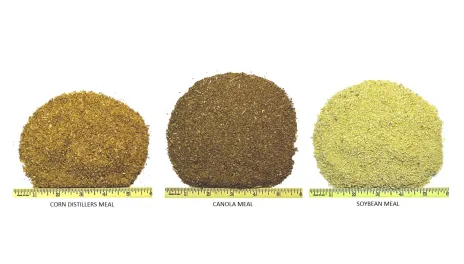Protein Co-products for Growing Cattle
Many crops produced in North Dakota are marketed for the production of alternative fuels. The demand for renewable diesel fuel derived from soybean and canola, and for ethanol derived from corn, creates unique markets for livestock producers in the central portion of the US. Specifically in North Dakota, livestock producers have the opportunity to feed co-products including canola meal, distillers grains plus solubles, and soybean meal. This can be good news, as additional options for required protein continue to be an expensive component in cattle rations.
Beef cattle have a metabolizable protein requirement. Metabolizable protein is the combination of rumen degradable protein (RDP), rumen undegradable protein (RUP), and microbial protein. Rumen degradable protein is protein is easily degraded within the rumen, making nitrogen available for use by the rumen microbiome. Rumen undegradable protein, also known as undegradable intake protein, bypass protein, or escape protein, is protein not digested within the rumen but rather absorbed through the small intestine and used by the animal. Lastly, microbial protein is the remnant of microbia flowing out of the rumen and absorbed in the small intestine by the animal.
When cattle are fed diets containing corn or barley, protein must be supplemented to optimize growth rate. Growth will be depressed if protein concentrations are limiting even in the finishing period in the feed yard. A freshly weaned 450-pound steer will require approximately 20% crude protein to gain 1.25 pounds per day. Additional dietary energy will decrease the requirement for protein. The same 450-weight steer requires 17% crude protein to gain 2.25 pounds per day.
Much research has been done on soybean meal and distillers grains, and how different types of protein can enhance growth in fed cattle. Based off the 2016 Beef NRC (NASEM, 2016), average crude protein levels are 40%, 30%, and 46% for canola meal, dried distillers grains, and soybean meal, respectively. Additionally, the RUP levels in CM, DDGS, and SBM are approximately 42%, 68%, and 44%, respectively. Research suggests an RDP:RUP ratio of between 65:35.
Throughout this coming winter and spring, the CREC Livestock Unit will be feeding canola meal, distillers grains plus solubles, and soybean meal at 13% and 15% crude protein levels. Limited research has been conducted to simultaneously identify the benefits between canola meal, corn distillers grains, and soybean meal during finishing. Nearest results were from Good, et al. (2017), where the author investigated the performance and carcass characteristics of finishing cattle fed canola meal versus soybean meal with and without wheat dried distillers grains and found no differences.
Work with your local NDSU County Extension Agent and regional Extension Specialists to locate available co-products and for assistance in balancing rations.
Colin Tobin, Ph. D.
Colin.Tobin@ndsu.edu
Animal Scientist
